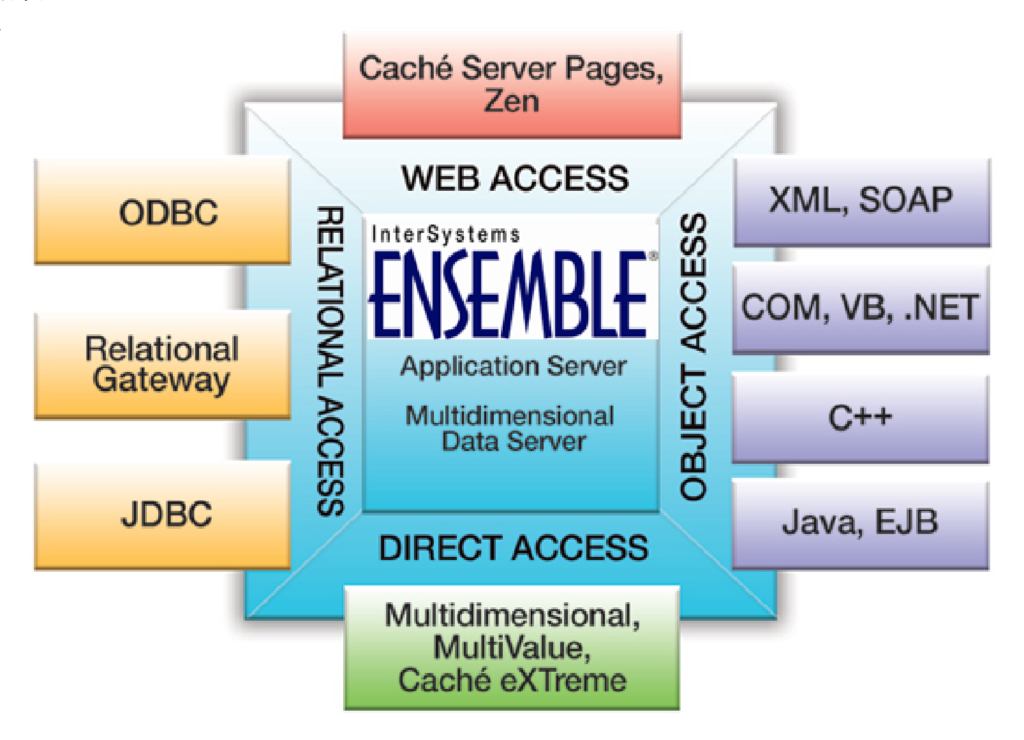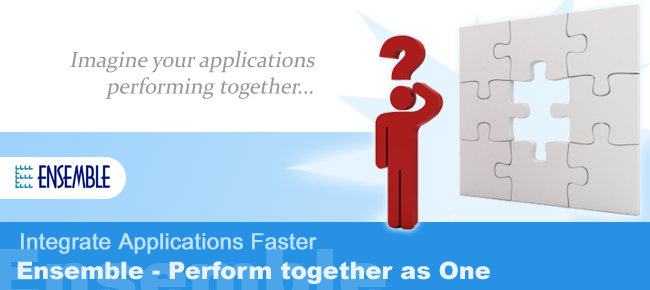Together but not scrambled

The high flexibility of Intersystem’s Ensemble product, allows us to implement integrated systems in so many different standard and non standard ways, that ensures the highest success.
Therefore, one of the key questions we face nowadays whenever we have to analyze the current status of any installation is the integration of the various existing systems between them, or together with a new forecoming system.
As an example, we can think about the typical scenario we find in a hospital, where the Hospital Information System software, the Laboratory Information System software, and the Accounting or ERP software belong to different software manufacturers, and therefore, the communication between them, becomes something vital for the hospital daily performance.
International Online has a vast experience in system integration, gathered in all our years of experience. Our aim, a goal constructed over the years, is to integrate the systems in such a smooth way, that becomes transparent for the end users, reduces IT systems maintenances, and raises the performance and the stability of the whole integrated system.
During all our years of experience, we have faced many varied and different IT systems installations in our customers, all of them composed by a mixture of different platforms, operative systems, softwares, middlewares, all of them interconnected to perform the whole set of needs fulfillments, and in most of the cases, some of the systems have become difficult to replace for so many reasons.


InterSystems Ensemble® is a seamless platform for rapid connectivity and the development of new connectable applications. It includes the comprehensive range of technologies needed for any connectivity task, in a unified “single stack” architecture that provides ease-of-use and enables rapid project completion. Ensemble users typically complete projects twice as fast compared to previous generations of integration products.
Ensemble is used by enterprises that want advanced integration technology to overcome the limitations of traditional interface software and time-consuming point-to-point methods. By establishing enterprise service bus (ESB) and service-oriented architecture (SOA) infrastructures, Ensemble enables the creation of composite applications that preserve and extend previous software investments.
Ensemble is also used by application vendors. It provides a competitive advantage by enabling developers to rapidly create new “connectable” applications that can share data with existing applications.
Sophisticated technology supports Ensemble’s ability to make any integration project easier and faster to complete. It starts with the proven, powerful, and massively scalable object technology of the InterSystems Caché database. Ensemble is built on Caché, enabling your Ensemble-based solutions to scale easily to handle thousands of simultaneous users and terabytes of data. The successful solutions you create will always be able to handle their own success, virtually unlimited in ability to handle increasing demand.
All elements of Ensemble are modeled as object classes in the Caché database. This object model is extended, as you develop a solution, by Ensemble’s advanced abstraction facility to all of the applications, services, data sources, business rules, and other components you’re using. In addition, Ensemble’s database is a repository for every message generated by a working solution, and for the current state of every business process. With Ensemble, messages are never lost, and an interrupted business process can always restart from the point of interruption. Sophisticated transactional bitmap indexing enables real-time updating of, and access to, the message database for analytics, business activity monitoring, auditing, and management.
Ensemble’s object model, shared database, and development environment provide a consistent, unified view of the underlying systems, applications, and services in a solution – no matter what platforms, languages, data models, storage architectures, network protocols, or other technologies those underlying parts use. Ensemble reduces the complexity typically associated with integration projects, incorporates services and data as needed into different business processes, and drastically reduces time to solution.
Enterprise Service Bus (ESB) & Service-Oriented Architecture (SOA)
From small projects to major new business processes, Ensemble’s enterprise service bus (ESB) and support for service-oriented architecture (SOA) provide all the tools needed to create breakthrough solutions in record time, with the reliability your enterprise can count on. Ensemble’s rapid integration and development capability enables you to evolve your infrastructure to SOA by creating new services, service-enabling legacy applications, and integrating them using the ESB.
With Ensemble it is much easier to develop functionality than with any other integration platform I have ever experienced. Thanks to its SOA architecture, what you’re in effect doing is creating new business processes, rather than coding new functionality. This makes doing complicated things relatively simple. After all, you don’t have to change any of the underlying systems in any way – you simply implement new logic.
Donna Davis
IT Manager, Shlomo Group
Ensemble’s ESB is a messaging and event-processing powerhouse because it’s built on the high-performance database technology of InterSystems Caché, enabling your Ensemble-based solutions to scale easily to handle thousands of simultaneous users and terabytes of data. The successful solutions you create will always be able to handle their own success, virtually unlimited in ability to handle increasing demand.
Ensemble is the most efficient platform for integration projects and creation of composite applications because it is a unified, state-of-the-art technology with all the functionality needed for business process management, business rule creation and execution, data transformations, event processing, and portal and dashboard creation. It enables you to rapidly incorporate existing services and applications in new solutions, orchestrate new business processes, automate event detection and response, and integrate data from across the enterprise.
Ensemble is used worldwide as a platform for SOA and mixed technology integration projects in industries as diverse as healthcare, financial services, logistics, energy, government, publishing, and manufacturing. Use the following links for more information on Ensemble ESB and SOA.
Business Process Management (BPM) & Workflow
Fusion power for better, faster application development
Ensemble is a rapid integration and development platform that combines business process management (BPM) with information management, workflow, and composite application creation capabilities. This fusion enables business analysts and developers to collaborate for faster modeling, integration, automation, execution, and monitoring of business processes, such as checking a patient into a hospital or processing a mortgage application.
Ensemble includes a rich graphical editor for:
- Diagramming processes and information flows.
- Including business rules and human workflow tasks in composite applications.
- Specifying the logical interactions between applications and services without lower-level concerns about interfaces, adapters, or middleware mechanisms.
- Automatic generation of executable code for the business process.
As a result, development and deployment of applications is faster, they are a better match to business requirements, and they can be reconfigured rapidly when the business process changes.
Capabilities
BPM is one part of the fully integrated Ensemble platform that’s used for connecting people, processes, data, and applications within and between organizations. Listed below is a sampling of the business process management (BPM) features and capabilities that make Ensemble the best platform for developing agile, connected applications:
Business process orchestration
- Graphical modeling lets developers or business analysts focus on integration and workflow, rather than technology. Ensemble generates executable code from the model.
- Developers can define business logic via these graphical models, or XML documents, or code. The ability to “mix and match” these tools enables your organization to efficiently address the widest range of requirements.
Enterprise Service Bus (ESB)
- Enables your organization to integrate and manage all of its SOA and non-SOA software assets through Ensemble.
- An embedded Caché database records all messages and system interactions across the bus for easier debugging, reporting, and auditing.
Business rules engine
- Business analysts and support personnel can quickly configure and change the behavior of working business processes via easily editable rules, rather than coding.
- Rules are separate from business logic and can be reused and modified easily.
Adaptable workflow engine
- Incorporates human workflow into otherwise automated processes.
- Separates user-based process definitions from business logic for easier and more reliable development.
Composite application development and service creation
- Create, deploy and incorporate services in multiple business processes.
- Service-enable legacy application functionality for reuse within Ensemble composite applications or exposure to external applications.
Business activity monitoring
- Monitor the activity and state of individual business processes, or the entire system, and key performance indicators.
- Analyze traffic passing through Ensemble to provide real-time business intelligence and event processing.
- Graphical dashboard displays enable appropriate and timely management decisions.
End-to-end management
- Rapidly diagnose and debug problems during development and live operations using Visual Trace.
- Real-time visibility into business processes as well as system performance.


